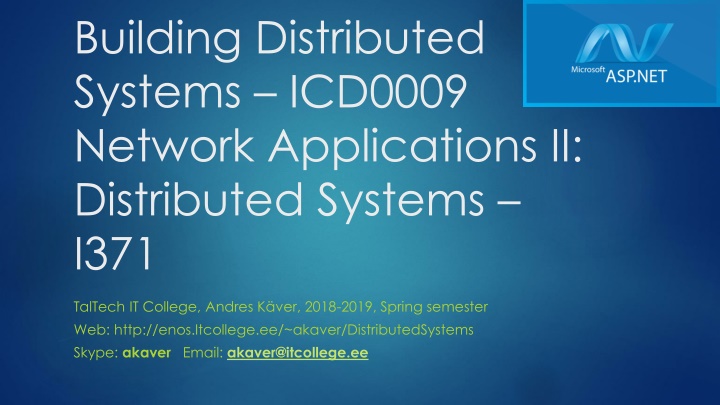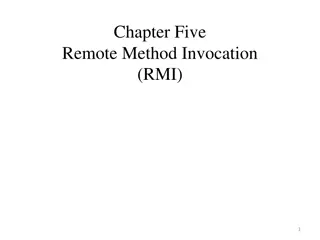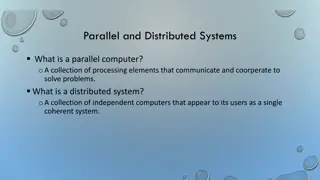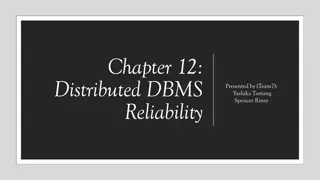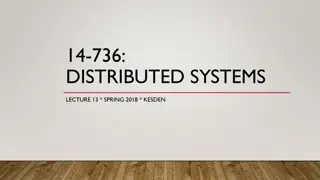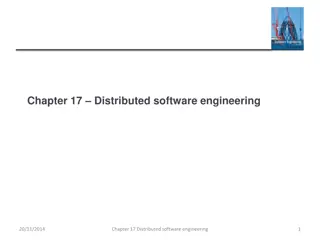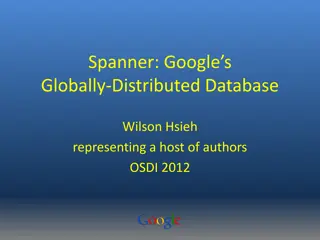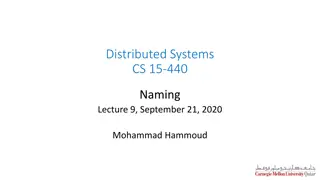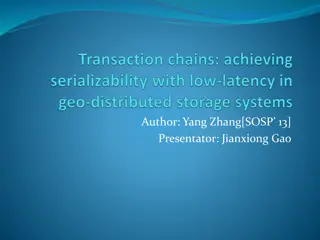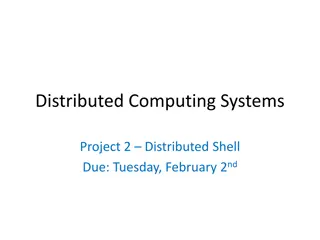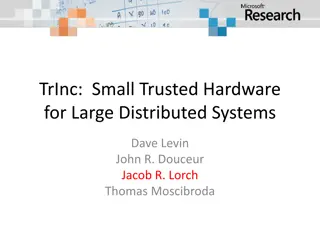Building Distributed Systems ICD0009 Network Applications II
Generics introduce type parameters in the .NET Framework, allowing the deferment of type specifications until instantiation. Constraints such as struct, class, new, base class, and interface help refine type arguments. Understanding these concepts is key for designing flexible and reusable classes and methods in distributed systems.
Download Presentation

Please find below an Image/Link to download the presentation.
The content on the website is provided AS IS for your information and personal use only. It may not be sold, licensed, or shared on other websites without obtaining consent from the author.If you encounter any issues during the download, it is possible that the publisher has removed the file from their server.
You are allowed to download the files provided on this website for personal or commercial use, subject to the condition that they are used lawfully. All files are the property of their respective owners.
The content on the website is provided AS IS for your information and personal use only. It may not be sold, licensed, or shared on other websites without obtaining consent from the author.
E N D
Presentation Transcript
Building Distributed Systems ICD0009 Network Applications II: Distributed Systems I371 TalTech IT College, Andres K ver, 2018-2019, Spring semester Web: http://enos.Itcollege.ee/~akaver/DistributedSystems Skype: akaver Email: akaver@itcollege.ee
Generics - <T> 1 Generics introduce to the .NET Framework the concept of type parameters, which make it possible to design classes and methods that defer the specification of one or more types until the class or method is declared and instantiated by client code. Generics are also known as parametrized types or parametric polymorphism.
Generics - example 2 // Declare the generic class. public class GenericList<T> { public void Add(T input) { // Do nothing } } class TestGenericList { private class ExampleClass { } static void Main() { // Declare a list of type int. GenericList<int> list1 = new GenericList<int>(); list1.Add(1); // Declare a list of type string. GenericList<string> list2 = new GenericList<string>(); list2.Add(""); // Declare a list of type ExampleClass. GenericList<ExampleClass> list3 = new GenericList<ExampleClass>(); list3.Add(new ExampleClass()); } }
Generics - Constraints 3 where T: struct The type argument must be a value type. Any value type except Nullable<T> can be specified. where T: class The type argument must be a reference type. This constraint applies also to any class, interface, delegate, or array type. where T: new() The type argument must have a public parameterless constructor. When used together with other constraints, the new() constraint must be specified last.
Generics - Constraints 4 where T: <base class name> The type argument must be or derive from the specified base class. where T: <interface name> The type argument must be or implement the specified interface. Multiple interface constraints can be specified. The constraining interface can also be generic. where T: U The type argument supplied for T must be or derive from the argument supplied for U. where T: unmanaged The type argument must not be a reference type and must not contain any reference type members at any level of nesting.
Generics - Constraints 5 Some of the constraints are mutually exclusive. All value types must have an accessible parameterless constructor. The structconstraint implies the new() constraint and the new() constraint cannot be combined with the struct constraint. The unmanaged constraint implies the struct constraint. The unmanaged constraint cannot be combined with either the struct or new() constraints.
Generics - benefits 6 Reusability with generics means that you will be able to create a method or a class that can be reused with different types in several places. Type safety and better performance both come together because at compile time the C# compiler will give errors and not compile whenever it knows there will an unsafe casting, and at runtime there will be no casting from type to type, it will be handled naturally. No Boxing/Unboxing - Boxing/Unboxing are costly operations, and it is always better to not rely on them heavily in your code. Why we always use the letter T - it is because by convention it refers to the word Type. You can use whatever valid letter or word you like for generics. The naming rules is no different than for naming classes.
Repository 7 It is not a good idea to access the database logic directly in the business logic. Tight coupling of the database logic in the business logic make applications tough to test and extend further. Problems: Business logic is hard to unit test. Business logic cannot be tested without the dependencies of external systems like database Duplicate data access code throughout the business layer (Don t Repeat Yourself in code - DRY)
Repository 8 Repository Pattern separates the data access logic and maps it to the entities in the business logic. It works with the domain entities and performs data access logic.
Repository 9 Capsulate data processing Classical way: SqlCommand( SELECT * FROM Customer where ID= + cid).Execute Create class instance Copy result data into object Repo: GetCustomerById(cid) Repo user is not aware where and how is data stored and retrieved (sql, web-api, xml, csv files,....)
Repository 10 How many and what types of repos to create? One per class/table Graph based Write only repo, read only repo One huge repo No right answers, you have to decide Every project and team has its own customs and requirements
Repository - interface 11 public interface IPersonRepository : IDisposable { IQueryable<Person> All { get; } IQueryable<Person> AllIncluding( params Expression<Func<Person, object>>[] includeProperties); Person Find(int id); void InsertOrUpdate(Person person); void Delete(int id); void Save(); } Next developer should only look at the repo interface. How repo operates - not important. Interface is also needed for dependency injection
Repository - code 12 public void InsertOrUpdate(Person person) { if (person.PersonID == default(int)) { // New entity context.People.Add(person); } else { // Existing entity context.Entry(person).State = EntityState.Modified; } } public class PersonRepository : IPersonRepository { ContactContext context = new ContactContext(); public IQueryable<Person> All { get { return context.People; } } public IQueryable<Person> AllIncluding( params Expression<Func<Person, object>>[] includeProperties) { public void Delete(int id){ var person = context.People.Find(id); context.People.Remove(person); } IQueryable<Person> query = context.People; foreach (var includeProperty in includeProperties) { query = query.Include(includeProperty); } return query; public void Save() { context.SaveChanges(); } } public void Dispose() { context.Dispose(); } public Person Find(int id){ return context.People.Find(id); } }
Using repo in console app 13 using ContactsLibrary; namespace RepoConsoleApp { class Program { static void Main(string[] args) { using (var repo = new PersonRepository()) { repo.InsertOrUpdate(new Person { FirstName = "Juku", LastName = "M nd" }); repo.InsertOrUpdate(new Person { FirstName = "Malle", LastName = "Tamm" }); repo.Save(); foreach (var person in repo.All.ToList()) { Console.WriteLine("{0} {1}", person.FirstName, person.LastName); } } Console.ReadLine(); } } }
Repository universal interface 14 public interface IEntityRepository<T> : IDisposable { IQueryable<T> All { get; } IQueryable<T> AllIncluding(params Expression<Func<T, object>>[] includeProperties); T Find(int id); void InsertOrUpdate(T entity); void Delete(int id); void Save(); } public interface IPersonRepository : IEntityRepository<Person> { }
Repository - Problems 15 Object graphs Disposed context If possible, avoid graphs. Operate with single objects. (Common in web-api/mvc)
Repository one more time 16 Repo container, data storage engine capsulation Typically CRUD methods, to operate on some concrete class Real data storage engine, with its implementation details is hidden from user Possibility to easily replace storage mechanism within application
Repository generic interface 17 public interface IRepository<TEntity> where TEntity : BaseEntity { IEnumerable<TEntity> All(); Task<IEnumerable<TEntity>> AllAsync(); TEntity Find(params object[] id); Task<TEntity> FindAsync(params object[] id); void Add(TEntity entity); Task AddAsync(TEntity entity); TEntity Update(TEntity entity); void Remove(TEntity entity); void Remove(params object[] id); }
Repository - generic 18 public class EFRepository<TEntity> : IRepository<TEntity> where TEntity : BaseEntity { protected DbContext RepositoryDbContext; protected DbSet<TEntity> RepositoryDbSet; public EFRepository(IDataContext dataContext){ RepositoryDbContext = dataContext as DbContext ?? throw new ArgumentNullException(nameof(dataContext)); RepositoryDbSet = RepositoryDbContext.Set<TEntity>(); } public virtual IEnumerable<TEntity> All() => RepositoryDbSet.ToList(); public virtual async Task<IEnumerable<TEntity>> AllAsync() => await RepositoryDbSet.ToListAsync(); public virtual TEntity Find(params object[] id) => RepositoryDbSet.Find(id); public virtual async Task<TEntity> FindAsync(params object[] id) => await RepositoryDbSet.FindAsync(id); public void Add(TEntity entity) => RepositoryDbSet.Add(entity); public virtual async Task AddAsync(TEntity entity) => await RepositoryDbSet.AddAsync(entity); public TEntity Update(TEntity entity) => RepositoryDbSet.Update(entity).Entity; public void Remove(TEntity entity) => RepositoryDbSet.Remove(entity); public void Remove(params object[] id){ var entity = RepositoryDbSet.Find(id); Remove(entity); } }
Repository generic - incorporating 19 public interface IPersonRepository : IRepository<Person> { } public class PersonEFRepository : EFRepository<Person>, IPersonRepository { public PersonEFRepository(IDataContext dataContext) : base(dataContext) { } }
